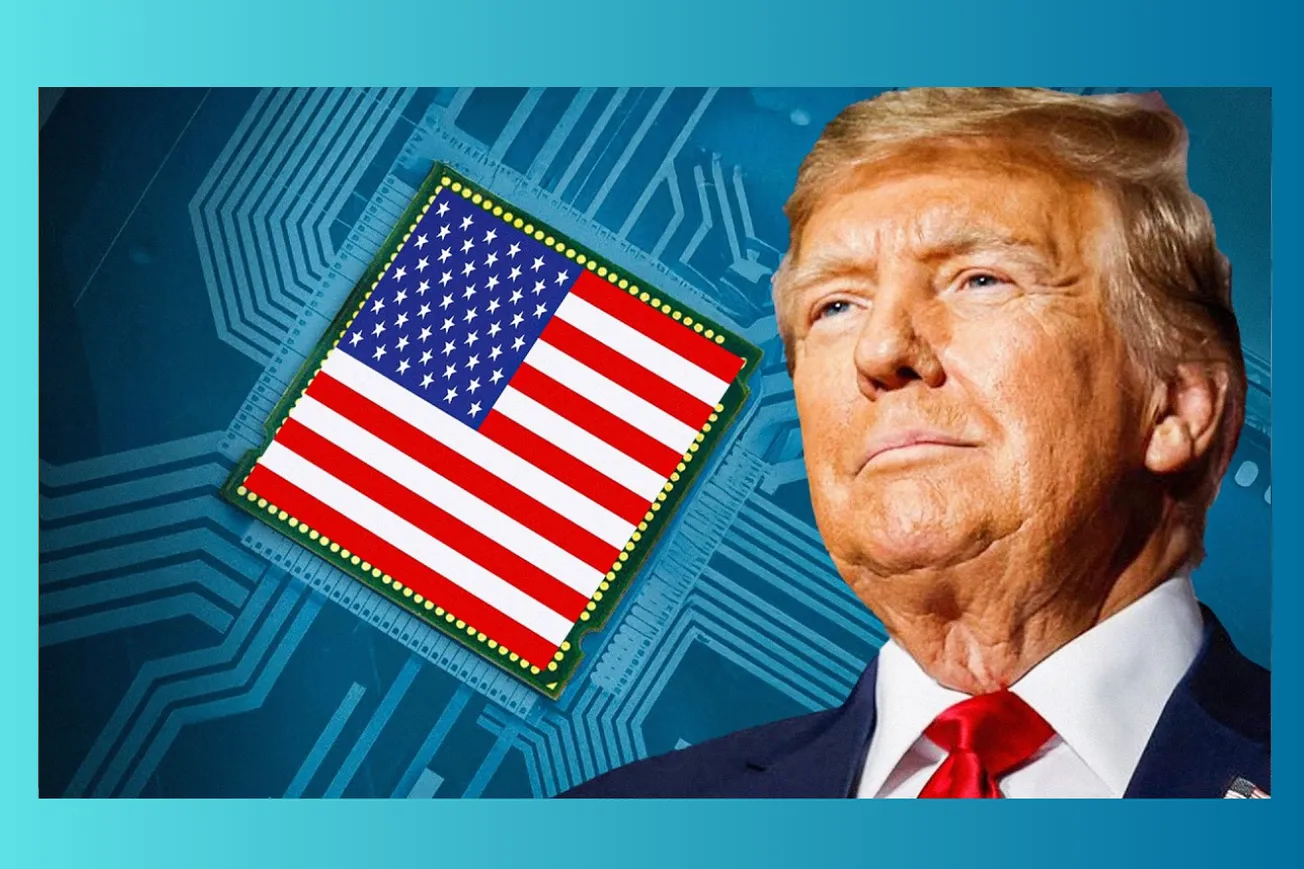Table of Contents
Former Intel government affairs chief Bruce Andrews reveals how America rebuilt its industrial policy muscle through the CHIPS Act and makes the case for reorganizing government around 21st-century economic competition.
Key Takeaways
- The U.S. government is fundamentally misorganized for modern economic competition, operating with 20th-century structures for 21st-century challenges
- In 2016, only two people in the entire federal government had expertise in semiconductors, highlighting America's institutional capacity gaps
- The CHIPS Act succeeded because of rare bipartisan agreement on the problem, solution, and need for government intervention
- Bruce Andrews proposes creating a "Department of Competitiveness" that consolidates all business-related economic development functions under one roof
- Silicon Valley's libertarian "leave us alone" culture is rapidly disappearing as geopolitics drives technology policy decisions
- Congressional staff expertise has declined significantly since the 1990s due to salary disparities with the private sector
- China's market represents 30-40% of semiconductor revenue, creating impossible choices between competitiveness and national security for U.S. companies
- Successful industrial policy requires "carrots" over "sticks" - incentives that help American companies compete rather than punishment mechanisms
The Expertise Crisis: When Government Had Two Semiconductor Experts
The most shocking revelation from Bruce Andrews' account of the CHIPS Act's origins isn't about Chinese competition or supply chain vulnerabilities - it's about America's stunning lack of institutional knowledge about one of its most critical industries.
When Andrews spoke to the Semiconductor Industry Association in November 2015 as Deputy Secretary of Commerce, the industry leaders had shifted from confident self-reliance to something approaching panic. "I saw what I would almost describe as a sense of fear in their eyes about the Made in China 2025 program and the big fund," Andrews recalls, referring to China's $250 billion semiconductor investment initiative.
The American response revealed a sobering reality about government capacity. When Andrews called the assistant secretary responsible for industry analysis to develop a semiconductor strategy, the response was telling: "I'll bring my one guy up and let's talk about it. We only have one guy doing this."
- The entire federal government had exactly two people with semiconductor industry expertise in 2016
- This lack of knowledge existed despite semiconductors being critical to national security and economic competitiveness
- The expertise gap forced government to rely almost entirely on industry input for policy development
- Years of "hands-off" governance had systematically eliminated technical knowledge from government agencies
- The crisis required emergency hiring of outside experts to staff the CHIPS Act implementation
This institutional amnesia didn't happen overnight. As Andrews explains, "We really don't have the muscle memory of how to really do industrial policy." Decades of assuming the private sector could handle everything had left government unprepared for strategic economic competition with countries that never abandoned industrial policy.
The Bipartisan Perfect Storm: How CHIPS Happened
Understanding why the CHIPS Act succeeded while so many other industrial policy initiatives fail requires examining the rare convergence of factors that made it possible. Andrews identifies three essential ingredients that aligned in ways that seem almost impossible to replicate.
First was bipartisan agreement on the problem. The semiconductor shortage during COVID provided a brutal education for both lawmakers and consumers. Andrews shares vivid examples: "One senator told us he actually bought a Ford F-150 truck, but it didn't have the heated seat available yet because the chip that would heat his seat was not available." When senators in cold states can't heat their car seats, semiconductor policy becomes personal.
Second was agreement on the solution. The cost gap between U.S. and Asian manufacturing was quantifiable - 30 to 55 percent - and the tools to address it were clear. As Andrews notes, "Taiwan and Korea and China have spent the last 30 years providing incentives to help their industries to be successful. The U.S. has sat on the sidelines and let the private sector do it."
- Clear problem identification: America's semiconductor manufacturing capacity had moved offshore
- Quantifiable solution: Close the 30-55% cost gap between U.S. and Asian production
- Bipartisan champion network: Leaders like Chuck Schumer, Todd Young, and John Cornyn worked across party lines
- National security imperative: Defense officials like Paul Selva actively supported the initiative
- Consumer impact: Everyday Americans experienced semiconductor shortages during COVID
Third was genuine bipartisan leadership willing to work "over the politics." Andrews credits champions like Todd Young and John Cornyn on the Republican side who "really helped push it through" even when the CHIPS Act got caught up in last-minute partisan battles.
Reimagining Government: The Department of Competitiveness Vision
Andrews' most ambitious proposal addresses the fundamental organizational problems that made the semiconductor expertise crisis possible. His vision for a "Department of Competitiveness" isn't just bureaucratic reshuffling - it's a recognition that America's cabinet structure is fundamentally misaligned with 21st-century economic competition.
"The executive branch is not organized in the right way that we really have a 20th century cabinet structure for 21st century problems," Andrews explains. When he met with counterparts from Japan's METI or China's Ministry of Commerce, they had "a much clearer set of mandates and authorities and a clearer set of responsibilities" with "basically all of the business related functions within the country within one agency."
The Department of Competitiveness would consolidate scattered functions that currently exist across multiple agencies:
Economic Development: Small Business Administration, Economic Development Administration, Minority Business Development Administration, and various SBIR programs spread across government
Technology Policy: NTIA, NIST, rural broadband programs, and technology initiatives currently housed in different departments
Trade Functions: Potentially merging International Trade Administration with USTR to create a "super trade organization"
Government Statistics: Consolidating Bureau of Labor Statistics, Bureau of Economic Analysis, and Census Bureau under one roof
- All business-related economic development would be centralized under competitiveness focus
- Technology policy coordination would end the current fragmentation across agencies
- Trade policy would have unified leadership rather than competing power centers
- Statistical analysis would support coherent economic strategy rather than scattered data collection
Andrews acknowledges the political challenges: "Obama ran into trying to get this consolidation authority because Congress didn't want to give up the various committee jurisdictions." The Commerce Department currently reports to "eight full committees and 79 subcommittees" - a structure that makes coherent policy nearly impossible.
The Decline of Congressional Expertise: Why Talent Fled the Hill
The CHIPS Act's success required extraordinary effort partly because Congress itself lacks the deep technical expertise it once possessed. Andrews traces this decline to structural changes that began in the 1990s and accelerated with the growth of lobbying.
"In the early and mid-90s, the quality of the staff - and this is not to say there aren't some really tremendous staff on Capitol Hill still - but there was really deep expertise," Andrews recalls. The problem isn't individual capability but systemic incentives that drain talent from government service.
The core issue is compensation. "If you're a young Hill staffer, even a very experienced Hill staffer, you look out and your colleagues in the private sector are making two or three times what you're making," Andrews explains. This creates a vicious cycle where the most capable staff leave for better-paying private sector jobs, taking their expertise with them.
- Congressional salaries haven't kept pace with private sector competition
- Lobbying growth has created lucrative exit opportunities for experienced staff
- Higher turnover rates mean less institutional memory and expertise accumulation
- Stress and criticism of public service further discourage long-term careers
- The expertise gap forces Congress to rely more heavily on industry input for technical issues
The implications extend beyond individual career choices. As Andrews notes, "You also cycle people through the executive branch. So you have people who start out in Congress and then when their party takes over the executive branch, they move into the executive branch." This creates additional instability and prevents the deep expertise development that effective governance requires.
Industry's Education Campaign: How Semiconductors Got Smart About Washington
The semiconductor industry's relationship with government illustrates how quickly strategic thinking can change when existential threats emerge. For decades, the industry epitomized Silicon Valley's libertarian approach to government relations - minimal engagement, maximum independence.
"The semiconductor industry has never been a particularly big or politically active [industry]. They don't have big PACs. It's not like a lot of industries where there's a huge amount of money flowing through. It's actually been a relatively unsophisticated in Washington industry," Andrews explains.
This hands-off approach worked when global competition operated primarily through market forces. But China's Made in China 2025 strategy changed the game by deploying state resources for strategic advantage. As Andrews describes, when he met with semiconductor CEOs in 2015, their previous confidence had been replaced by recognition that "we're not just competing with companies, we're competing with countries."
The industry's government affairs evolution followed this strategic awakening:
Phase 1: Libertarian Independence - "Government stay out of our way, we don't need your help"
Phase 2: Problem Recognition - Realization that state-backed competition required government response
Phase 3: Solution Development - Working with government to identify tools and authorities needed
Phase 4: Legislative Partnership - Active collaboration on CHIPS Act development and passage
- Industry provided essential technical expertise that government lacked
- SIA became "really good at providing data and providing information that gives a very full and complete picture"
- Companies learned to frame issues in terms of national competitiveness rather than narrow corporate interests
- The cost gap data (30-55% manufacturing disadvantage) provided clear policy targets
- Bipartisan education efforts helped build congressional understanding and support
Notably, this wasn't traditional lobbying but genuine policy education. As Andrews emphasizes, "Government affairs is really education. It is bringing information to government policy makers to help understand the challenges that the private sector is facing."
Quote Analysis: The New Reality of Strategic Competition
Two quotes from Andrews capture the fundamental shift in how American companies must think about global competition:
"When I was at Intel I would always say hey we're not just competing with companies we're competing with countries and I think that's the case that you've got many of these US companies going at it alone competing not just against their foreign competitors but the tools and resources of their foreign competitors government as well."
This observation highlights the asymmetric nature of modern economic competition. While American companies operate primarily through market mechanisms, they face rivals backed by comprehensive state support. Chinese semiconductor companies don't just compete on technology and efficiency - they have access to subsidized capital, guaranteed markets, and strategic patience that individual companies cannot match. This creates an uneven playing field where free market principles become a competitive disadvantage rather than an advantage.
"For any company that does business in China and you can see sometimes companies that are really vocally anti-China, right, don't have any revenue in China. But for companies that want or need to be successful in the Chinese market to remain leaders and remain innovators and remain competitive then it's then it is definitely a delicate process."
This quote captures the impossible bind facing American technology companies. China represents 30-40% of the global semiconductor market - revenue that's essential for funding R&D and maintaining competitive position. Companies that lose access to this market face an innovation death spiral: reduced revenue leads to cuts in R&D spending, which leads to competitive decline, which further reduces market position. Yet maintaining China market access increasingly conflicts with U.S. national security objectives, creating strategic dilemmas that individual companies cannot resolve alone.
The China Dilemma: When National Security Meets Economic Reality
Perhaps no aspect of modern industrial policy creates more complex challenges than managing the relationship with China. Andrews' experience at Intel provides crucial insights into how companies navigate between economic necessity and national security requirements.
The numbers make the dilemma stark: "About 30 to 40% of the market is in China" for semiconductor companies. As Andrews explains, "If you lose 30% of your revenue, you're dead. There is no company. If you lose 30% of your revenue, you stop being competitive."
This creates what Andrews calls "a very challenging calculation for any company to make." Companies must balance multiple considerations: maintaining revenue streams essential for R&D investment, respecting U.S. export controls and national security concerns, and competing against Chinese companies that may prefer American technology but are increasingly developing domestic alternatives.
- Chinese market access is essential for maintaining R&D budgets and competitive position
- Export controls can accelerate Chinese indigenous innovation rather than slowing it down
- Companies face different risk profiles based on their revenue exposure to China
- Government policy must balance "helping American companies run faster" with security concerns
- The "small yard, high fence" approach requires careful calibration to remain effective
Andrews references Eric Schmidt's warning that excessive export controls can be counterproductive: "Sometimes export controls if you go too far on export controls what you actually end up doing is accelerating indigenous innovation in China." The goal should be maintaining American technological leadership while managing genuine security risks, not forcing binary choices that ultimately weaken U.S. competitiveness.
From Libertarian to Lobbyist: Silicon Valley's Washington Awakening
The transformation of Silicon Valley's relationship with government represents one of the most significant shifts in American technology policy. Andrews witnessed this evolution firsthand, from an industry that proudly avoided Washington to one that recognizes government engagement as essential for survival.
The semiconductor industry exemplified this libertarian tradition. As Andrews notes, "There has always been particularly in Silicon Valley but in a lot of other industries a deep libertarian streak where it's like hey we don't need help from government basically leave us alone we'll compete we'll be successful we can do this we don't need you."
This approach worked when technology competition remained primarily in commercial markets. But geopolitics changed everything. Export controls, national security reviews, trade policies, and strategic competition with China made government policy central to business strategy.
The awakening wasn't gradual - it was often sudden and dramatic. Andrews shares the example of Nvidia, which "didn't have a PAC. They didn't have any lobby they didn't have anybody registered to lobby probably until 2022." When he first met with them years earlier, "they said, 'Oh yeah, we have nobody registered to lobby in Washington. We don't do lobbying.'"
- Silicon Valley's libertarian culture created systematic underinvestment in government relations
- Geopolitical competition forced recognition that government policy shapes business outcomes
- Export controls and national security reviews made Washington engagement essential
- Companies with physical manufacturing locations understood government importance earlier
- The shift from "leave us alone" to active engagement happened rapidly once threats became clear
Trump's trade policies are accelerating this transformation across all industries. As Andrews observes, "Trump trade policy is going to put that to bed for literally every industry probably for... it's been a wakeup call to a lot of companies for sure."
Carrots vs. Sticks: The Art of Effective Industrial Policy
Andrews' approach to industrial policy emphasizes incentives over punishment, recognizing that successful economic competition requires helping American companies succeed rather than simply restricting competitors. This philosophy shaped both the CHIPS Act and his recommendations for future policy.
"I tend to be a carrot guy, not a stick guy," Andrews explains. "Like I think the stick can work in certain cases, but you're better off having the carrots." This approach recognizes that American companies need to "run faster" rather than simply hobbling their competition.
The CHIPS Act exemplified this approach through investment tax credits and manufacturing incentives designed to close cost gaps rather than punish overseas production. Future policies could extend this logic through design tax credits for fabless companies, but only if they manufacture in the United States.
Effective Industrial Policy Principles:
- Focus on making American companies more competitive rather than making competitors less competitive
- Target specific cost disadvantages that government policy can address effectively
- Tie incentives to domestic production and employment rather than offshore activities
- Maintain flexibility to adjust policies as competitive dynamics evolve
- Recognize that successful companies need access to global markets, including challenging ones like China
The alternative - stick-heavy approaches - often backfire by harming American competitiveness. Andrews provides a crucial example: "If you put a 25% tariff on an EUV lithography machine coming from Europe that Intel has to buy with those tariffs, but their foreign competitors in Taiwan, Korea, China don't have, what happens fairly quickly is it makes US companies completely non-competitive as manufacturers."
Looking Ahead: Building Government for the 21st Century
Andrews' vision extends beyond the CHIPS Act to fundamental questions about how government must evolve to support American competitiveness. His Department of Competitiveness proposal addresses structural problems that will only grow more severe as economic competition becomes more strategic and geopolitical.
The current system's fragmentation creates multiple problems: overlapping jurisdictions that prevent coherent policy, expertise scattered across agencies that don't communicate effectively, and committee structures that prioritize turf protection over national strategy. Meanwhile, competitors like China benefit from unified command structures that can coordinate across economic, technology, and security domains.
Building effective industrial policy capacity requires several elements:
Organizational Reform: Consolidating business-related functions under unified leadership with clear authorities and responsibilities
Expertise Development: Investing in government talent through competitive compensation and career development paths that retain technical knowledge
Flexible Tools: Creating authorities that can respond to evolving competitive challenges without requiring new legislation for each industry or threat
Bipartisan Sustainability: Ensuring policies survive political transitions through broad consensus on strategic objectives
- Government organization must match the integrated nature of modern economic competition
- Technical expertise requires investment in human capital, not just systems and processes
- Policy tools need flexibility to address diverse challenges across different industries and timeframes
- Success requires sustained commitment across multiple election cycles and political transitions
Andrews concludes with a broader observation about government effectiveness: "It's always been very clear to me we are not organized for how the world exists today, we're organized for how it used to exist, and to be successful we've got to do" the work of fundamental reform.
The CHIPS Act proved that America can still execute ambitious industrial policy when circumstances align. The question is whether the country can build the institutional capacity to make such successes routine rather than exceptional. As Andrews notes, the Department of Competitiveness "is all we can hope for for the next few years" - but it's also exactly what America needs to compete effectively in the 21st century.
The Path Forward: Lessons from CHIPS for Future Industrial Policy
The CHIPS Act's success provides a template for effective industrial policy, but replicating its achievements requires understanding both what worked and why those conditions may be difficult to recreate. Andrews' analysis suggests that future success depends on building institutional capabilities that don't rely on crisis-driven perfect storms.
First, the expertise problem must be addressed systematically. Having only two government experts on critical industries is a national security vulnerability that extends far beyond semiconductors. Building sustainable expertise requires addressing the compensation gaps that drive talent away from public service, creating career paths that reward deep technical knowledge, and developing institutional memory that survives political transitions.
Second, the organizational fragmentation that makes coherent industrial policy so difficult must be tackled directly. The Department of Competitiveness proposal offers one approach, but the broader principle is clear: 21st-century economic competition requires government structures designed for integrated challenges rather than 20th-century bureaucratic silos.
Key principles for sustainable industrial policy capacity:
- Build expertise before crises emerge rather than scrambling to develop knowledge during emergencies
- Create organizational structures that match the integrated nature of modern economic competition
- Develop flexible policy tools that can address diverse challenges without requiring new legislation each time
- Maintain bipartisan consensus on strategic objectives even when tactical approaches differ
- Balance carrots and sticks to help American companies compete rather than simply restricting competitors
- Recognize that global market access remains essential for maintaining technological leadership
- Invest in long-term institutional capacity rather than relying on crisis-driven political alignment
The CHIPS Act succeeded because rare circumstances aligned: bipartisan recognition of the problem, clear quantifiable solutions, and champions willing to work across party lines. Building institutional capacity means creating systems that can generate similar results without requiring such exceptional political conditions.
As Andrews observes about his time in government, the goal should be maintaining America's competitive advantages while developing new ones: "We don't want to recreate that. We don't want to copy, but we need to establish our own model that works." The CHIPS Act provides proof that America can still execute ambitious industrial policy. The challenge now is making such capabilities routine rather than miraculous.





